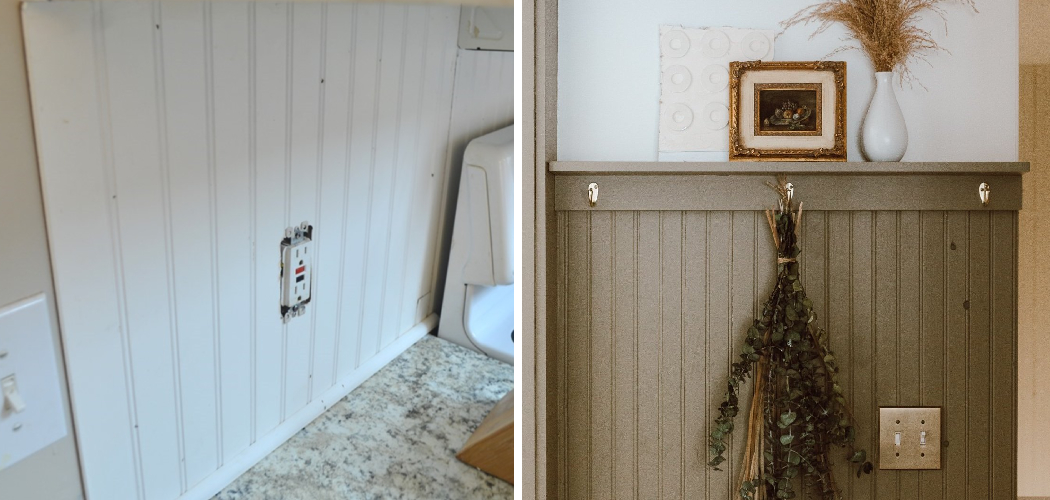Beadboard is a classic and versatile option for adding texture and character to any room in your home. Whether you are looking to create a charming cottage feel or add a touch of sophistication, beadboard can help you achieve the look you desire.
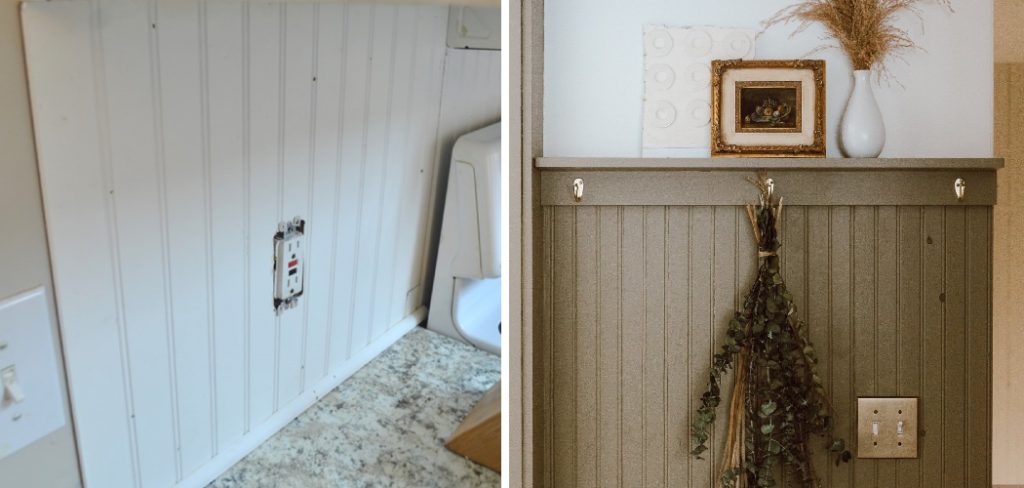
If you’re wondering how to put up beadboard, it’s easier than you might think. In this guide, we’ll walk you through the steps on how to put up a beadboard to give your home a fresh and stylish update. So roll up your sleeves and get ready to transform your space with beadboard!
Understanding Beadboard
Beadboard is a wood paneling type with narrow, vertical grooves or beads. These grooves are typically 2-3 inches wide and run the length of each panel. Beadboard can be made from different types of wood, such as pine, oak, or cedar, which gives you flexibility in choosing the right look for your space.
It’s also available in different finishes, including natural wood, painted, or stained. Beadboard is a popular choice for many homeowners because it adds visual interest and texture to walls and ceilings while still being affordable and easy to install.
Tools and Materials You Will Need to Put Up Beadboard
- Beadboard panels
- Measuring tape
- Level
- Stud finder
- Pencil
- Table saw or circular saw (if cutting beadboard panels)
- Finishing nails or adhesive
- Hammer or nail gun
- Adhesive caulk
- Paint or stain (if desired)
Step-by-step Guidelines on How to Put Up Beadboard
Step 1: Measure and Plan
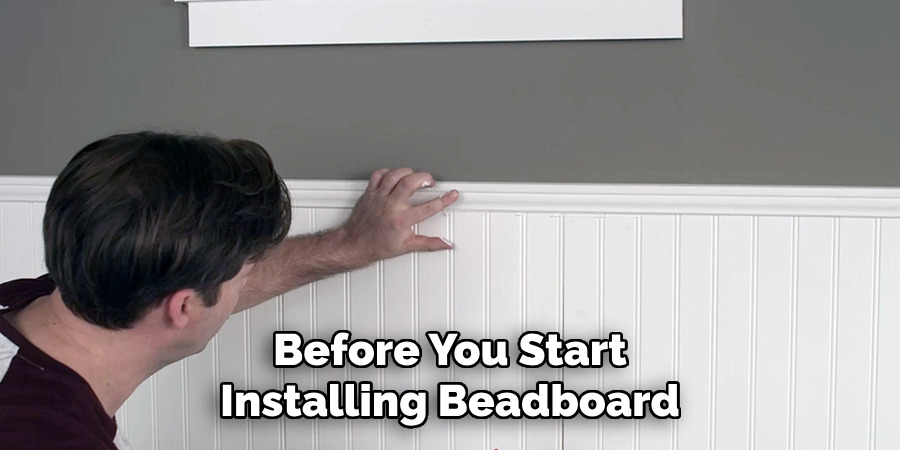
Before you start installing beadboard, it’s important to measure your space and plan out the layout. Use measuring tape to determine the length and width of the walls or ceiling where you want to install the beadboard. This will help you determine how many panels you need and if any cutting is required.
This is also a good time to decide on the direction you want the grooves of the beadboard to run. Consider the overall look and feel you want to achieve, and choose a direction that best suits your space.
Step 2: Locate Studs
Using a stud finder, locate and mark the studs on the wall or ceiling where you will be installing the beadboard. This is important as it will ensure that your panels are securely attached to the wall for long-lasting results. This step is especially crucial if you plan on using nails to secure the beadboard. If you are using adhesive, this step may not be necessary.
Step 3: Prepping the Beadboard Panels
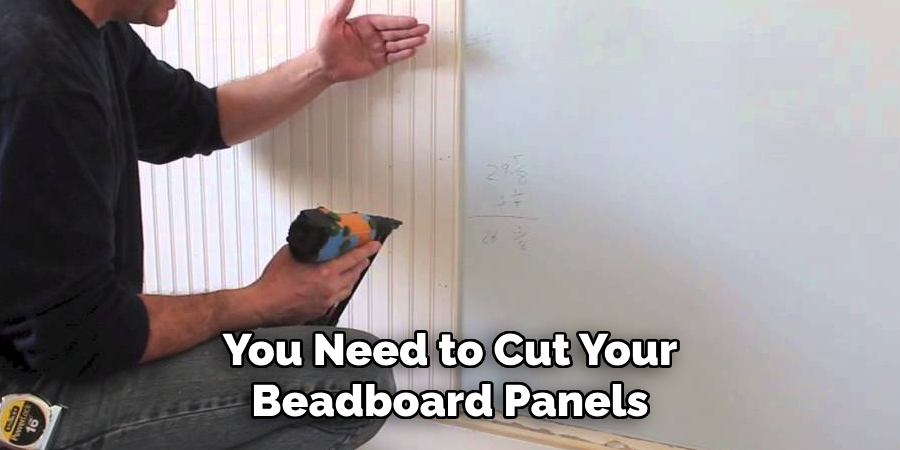
If you need to cut your beadboard panels to fit your space, now is the time to do so. Use a table saw or circular saw to make precise cuts according to your measurements.
Be sure to wear safety glasses and follow all safety precautions when using power tools. You can also choose to leave the panels uncut and trim them after installation if desired. Make sure to also sand any rough edges before proceeding.
Step 4: Install the First Panel.
Adhesive or nails are used to secure the first panel, which starts at one corner of the wall or ceiling. Be sure to check that it is level before securing it. If using adhesive, follow the manufacturer’s instructions for best results. If using nails, make sure they are driven into the studs for a secure hold. While installing, be sure to use spacers between the panels to allow for expansion and contraction due to changes in humidity.
Step 5: Continue Installing Panels
Continue installing panels along the wall or ceiling, using spacers between each panel as you go. Make sure to check that each panel is level before securing it. If necessary, cut any end pieces to fit. You can also use adhesive caulk to fill in any gaps between the panels for a seamless look. This will also help with the expansion and contraction of the wood.
Step 6: Finishing Touches
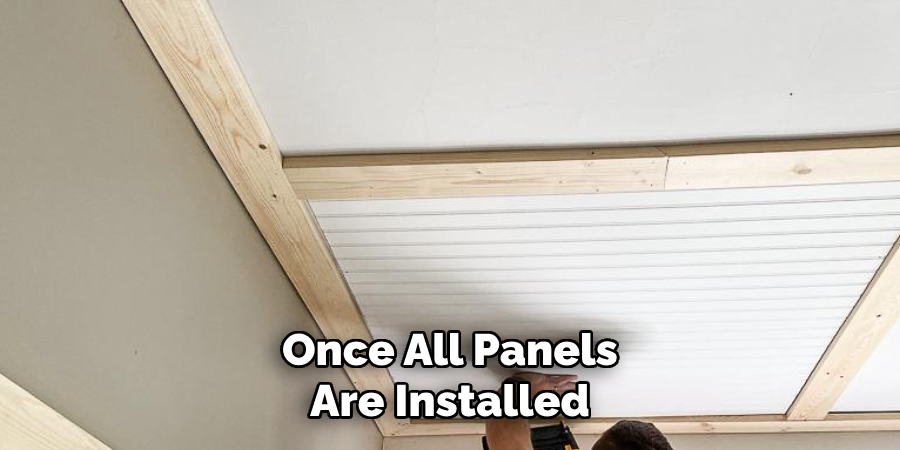
Once all panels are installed, fill any nail holes or gaps with wood filler and sand smooth. You can then paint or stain your beadboard to match your desired look. If you prefer a natural wood finish, you can also opt to seal it with a clear coat for added protection. Make sure to let the finish dry completely before adding any decor or furniture back into the room.
Following these steps will help you achieve a professional and polished look when installing beadboard in your home. With its timeless charm and easy installation, beadboard is the perfect addition to any room. So go ahead and give your space a fresh update with this classic design element. Happy renovating!
Additional Tips and Tricks to Put Up Beadboard
- If you’re having trouble making your beadboard look seamless, try painting the edges of each panel before installation. This will help hide any visible seams once everything is put up.
- To get a professional finish on your beadboard, use wood filler to fill in any gaps or nail holes. Then sand it smooth and paint over it.
- Remember the corners! Cut one panel at a 45-degree angle for inside corners and use it to cover the corner. Consider using corner molding for a clean and polished look for outside corners.
- If you’re installing a beadboard in a bathroom or other high-moisture area, be sure to choose a water-resistant option such as PVC beadboard.
- Consider installing a beadboard in a unique pattern, such as herringbone or chevron, to add some visual interest. Just make sure to plan out the layout before starting installation.
- If you don’t have the budget to cover an entire room in a beadboard, consider using it as an accent wall instead. This can create a focal point and add texture without breaking the bank.
- consider using a semi-gloss or high-gloss finish for easier cleaning and maintenance when painting your beadboard.
- If you’re using a real wood beadboard, consider staining it instead of painting for a more natural look.
- Don’t be afraid to mix and match different types of beadboard in a room for added dimension and texture. Just make sure they are all the same thickness for a seamless look.
- If you’re installing beadboard on a ceiling, use construction adhesive in addition to nails for extra security and to prevent sagging over time.
- Before starting your project, make sure to measure and plan out your cuts carefully to minimize waste and ensure a professional-looking installation.
- To add even more charm to a room with a beadboard, consider installing a chair rail or wainscoting along with it for a classic and elegant look.
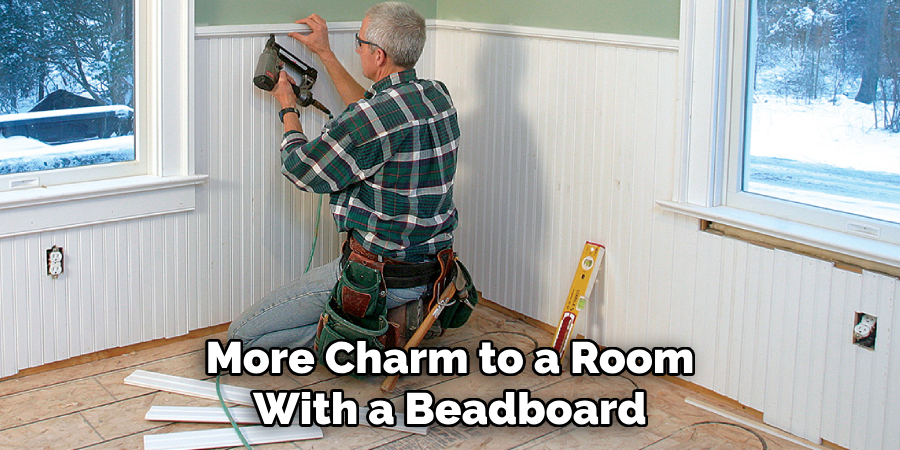
Following these tips and tricks will help you achieve a beautiful and successful beadboard installation in your home. Remember to take your time, plan carefully, and don’t be afraid to get creative with different styles and patterns. With some patience and attention to detail, you can transform any room with the timeless charm of beadboard. Happy decorating!
Things You Should Consider When Putting Up Beadboard
- The type of material you want to use is the first thing you should consider when putting up a beadboard. Beadboard comes in different materials, such as wood, MDF, and PVC. Each material has its own benefits and drawbacks, so it’s important to choose one that best fits your needs.
- Another important factor to consider is the space where you will be installing the beadboard. Measure the area correctly to make sure you purchase the right amount of beadboard and avoid any wastage.
- It’s also important to consider the style of the beadboard. Beadboard comes in various styles, such as traditional, v-groove, and shiplap. Choose a style that complements your overall interior design.
- When purchasing a beadboard, make sure to check the quality and thickness of the material. Thicker beadboard will be more durable and less prone to damage.
- Consider the color of the beadboard as well. If you plan on painting it, make sure to choose a material that takes paint well and matches your desired color scheme.
- Before installing the beadboard, prepare the wall by removing any existing wallpaper or paint and patching up any holes. This will ensure a smooth and even surface for the beadboard to be installed on.
- You should also consider the type of adhesive or nails you will use to attach the beadboard to the wall. Adhesives are more subtle and don’t leave visible nail holes, but they may not be as strong as nails.
- When installing the beadboard, make sure to use a level to ensure it is straight and even. This will help prevent any gaps or unevenness in the finished product.
- Take your time when cutting the beadboard to fit around corners or outlets. It’s better to measure twice and cut once to avoid any mistakes.
- Lastly, consider hiring a professional if you are not confident in your DIY skills. Installing beadboard can be a time-consuming and intricate process, so it’s important to make sure it is done correctly for the best results.
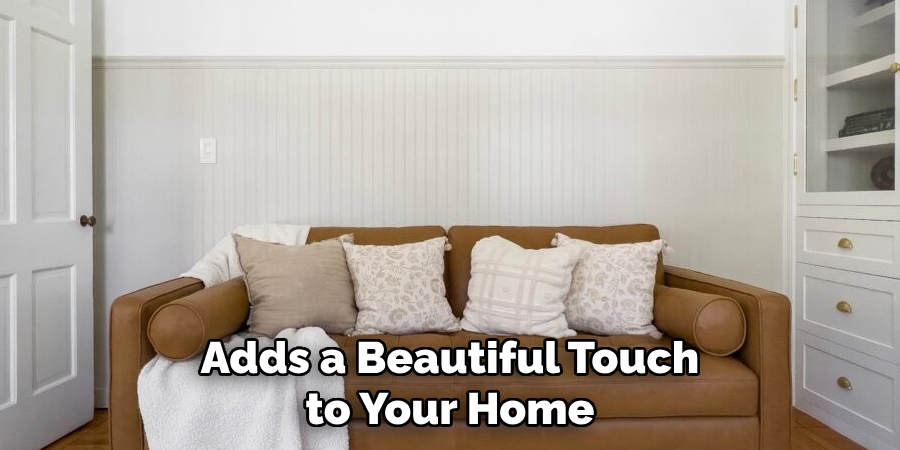
Following these considerations will help ensure that your beadboard installation is successful and adds a beautiful touch to your home. Remember to choose the right material, measure accurately, prepare the surface properly, and take your time during installation for a flawless finish. With careful planning and attention to detail, you can easily transform any room with the addition of a beadboard. So why wait? Start planning your beadboard project today and give your home a fresh look. Happy decorating!
Troubleshooting Common Issues to Put Up Beadboard
1. Warping or Shrinking:
Beadboard is made from natural wood, so it is prone to warping or shrinking due to changes in temperature and humidity. To prevent this issue, make sure that the beadboard is properly acclimated to the room before installation. This can be done by storing the beadboard in the room where it will be installed for at least 48 hours before beginning the installation process.
Additionally, make sure that the beadboard is properly sealed and finished with a water-resistant or waterproof sealant. This will help protect it from moisture and prevent warping or shrinking. If warping or shrinking does occur, it is best to replace the affected pieces rather than try to fix them. This will ensure a seamless and stable finish for your beadboard project.
2. Nail Pops:
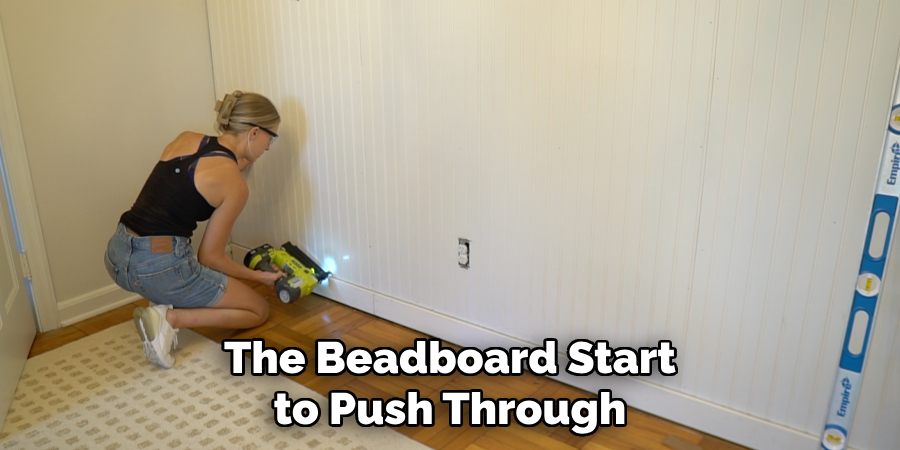
Nail pops occur when the nails used to secure the beadboard start to push through the surface, causing unsightly bumps or dips in the boards. To prevent nail pops, make sure to use the correct size and type of nails recommended for beadboard installation.
Also, be sure to install the nails at a slight angle rather than straight in, as this will provide better grip and stability. If you do notice nail pops after installation, carefully remove the affected nails and replace them with new ones in a slightly different location. This will help prevent the issue from recurring.
3. Gaps Between Boards:
Gaps between beadboard boards can occur due to improper installation or fluctuations in temperature and humidity. To avoid this issue, make sure to properly measure and cut each board before installing them.
Also, be sure to leave a small gap between each board (around 1/8 inch) to allow for natural expansion and contraction. If gaps do occur, they can be filled with a wood filler or caulk before painting or staining the beadboard.
4. Peeling Paint or Stain:
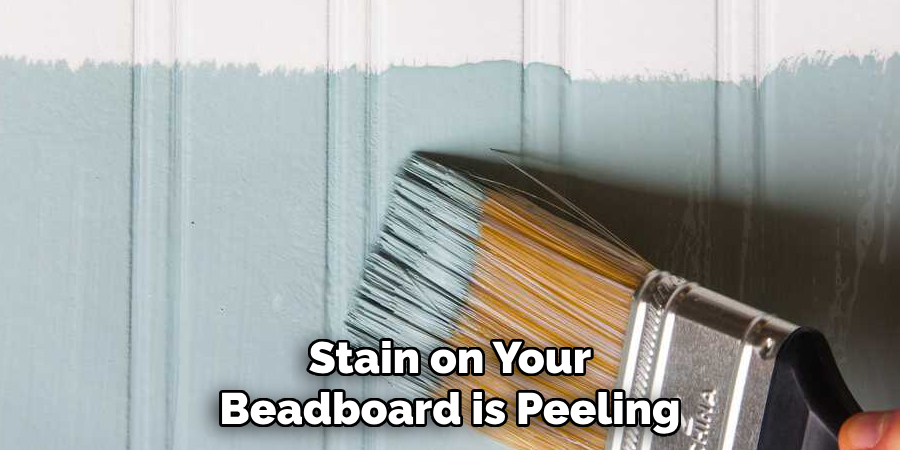
If you notice that the paint or stain on your beadboard is peeling, this could be a sign of poor adhesion. This can happen if the surface is not properly cleaned and prepared before painting or staining. To avoid this issue, make sure to thoroughly clean and sand the beadboard before applying any finish.
Also, be sure to use a high-quality primer and paint or stain formulated for wood surfaces. Properly sealing the beadboard after installation can also help prevent peeling in the future.
5. Insect Damage:
Beadboards made from natural wood can be susceptible to insect damage, such as termites or carpenter ants. To avoid this issue, make sure to properly seal and finish the beadboard with a protective sealant.
If you do notice any signs of insect damage, it is important to address the issue immediately by consulting a professional pest control service. Waiting too long can result in further damage and compromise the structural integrity of your beadboard installation.
Following these tips and troubleshooting common issues can help ensure a successful beadboard project that will add charm and character to any space. Remember to properly prepare and seal the beadboard, use the correct materials and techniques for installation, and address any issues promptly for a beautiful and long-lasting finish.
Frequently Asked Questions
What is Beadboard?
Beadboard is a type of decorative wall paneling made from narrow wood planks that are tongue-and-groove joined. It has a distinctive design featuring vertical grooves or ridges, known as “beads,” and indentations between each board. Beadboard is commonly used for wainscoting, trim, and backsplash applications due to its durability and classic look.
Why Use Beadboard as a Backsplash?
Beadboard backsplashes are popular for kitchens and bathrooms because they add texture, visual interest, and charm to the space. They also provide protection from water and food splatters, making them both functional and decorative. Beadboard is also budget-friendly compared to other backsplash materials such as tile or stone.
How Do You Install Beadboard as a Backsplash?
Installing beadboard as a backsplash requires measuring and cutting the paneling to fit your space and then securing it with adhesive or nails. It’s essential to properly prepare the surface by cleaning it and ensuring it’s smooth and flat before installation. You may also need to cut holes for outlets or switches, which can be done with a jigsaw.
Can Beadboard Backsplashes Be Painted?
Yes, beadboard backsplashes can be painted in any color you desire. Many people choose to paint them white for a classic, clean look, but you can also opt for a bolder color to add a pop of personality to your space. Before painting, it’s crucial to clean and lightly sand the surface to ensure proper adhesion of the paint.
How Do You Clean and Maintain Beadboard Backsplashes?
Beadboard backsplashes are relatively low maintenance and easy to clean. Wipe the surface with a damp cloth and mild soap for regular cleaning. You can use a gentle cleaner and a soft-bristled brush for tougher stains.
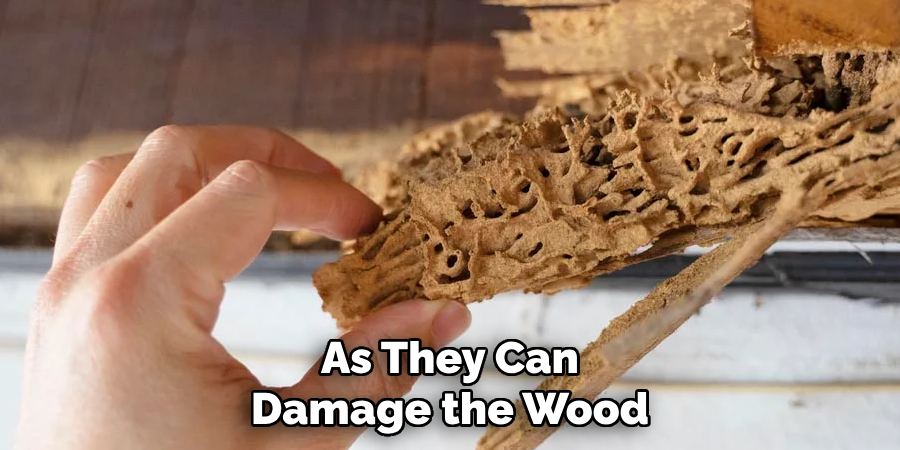
Avoid using abrasive materials or harsh chemicals, as they can damage the wood. To maintain the look of your beadboard backsplash, periodically inspect it for any signs of wear and tear and make necessary repairs.
What Are Some Alternative Uses for Beadboard?
Aside from being used as a backsplash, beadboard has many other applications in home decorating. It can be used for wainscoting on walls, paneling on ceilings, or trim around doors and windows. Beadboard also works well in farmhouse-style decor and can be incorporated into furniture pieces such as headboards or kitchen islands.
Conclusion
Now you know how to put up beadboard and the various ways it can be used as a decorative element in your home. Whether you choose to use it as a backsplash or in other creative ways, beadboard is an affordable and versatile option that can enhance the look of any room.
So go ahead and give your space a touch of charm with this classic paneling material. So, get ready to bring some character and texture into your home with beadboard! Happy decorating!

